Jun 9 2020
According to the authors of a new study, while national quotas on carbon dioxide (CO2) emissions have been set by the Paris Agreement, the same has not been done to remove this gas—a fact that should be urgently addressed.
 Reforestation is one way to capture carbon dioxide. Image Credit: Matt Kay/Shutterstock.
Reforestation is one way to capture carbon dioxide. Image Credit: Matt Kay/Shutterstock.
The objective of the Paris Agreement is to make sure that the rise in global temperature this century remains much below 2 °C above the pre-industrial levels, and to track efforts to restrict it to 1.5 °C.
But to reach these targets, mitigation measures will be required, that is, reduction of CO2 emissions resulting from changes such as increased consumption of renewable energy sources, and removal of atmospheric CO2 through carbon capture and storage (CCS) and reforestation.
However, while nations signed up to the Paris Agreement have their individual quotas required to fulfill this target in terms of mitigation and also have separate plans for doing so, no agreed national quotas exist for CO2 removal.
In a study published recently in the Nature Climate Change journal, an international team of scientists has debated that to fulfill the targets set by the Paris Agreement, CO2 removal quotas cannot be assigned in such a way that any one nation can meet its commitments alone.
Cross-Border Cooperation
According to the research team from Imperial College London, ETH Zürich, University of Girona, and the University of Cambridge, nations should now work collaboratively to ensure that sufficient CO2 is removed in an equitable and fair manner.
To accomplish this, decisions should be made on how to allocate quotas in a fair manner and a system should be developed, where nations that cannot meet their commitments alone can trade with other nations that have more capacity to remove CO2.
Carbon dioxide removal is necessary to meet climate targets, since we have so far not done enough to mitigate our emissions. Both will be necessary going forward, but the longer we wait to start removing CO2 on a large scale, the more we will have to do.
Dr Niall Mac Dowell, Study Co-Author, Centre for Environmental Policy and Centre for Process Systems Engineering, Imperial College London
Dr Dowell continued, “It is imperative that nations have these conversations now, to determine how quotas could be allocated fairly and how countries could meet those quotas via cross-border cooperation. It will work best if we all work together.”
Countries such as the UK and France have begun to adopt binding ‘net-zero targets’ and whereas there has been extensive focus on greenhouse gas emissions and emissions reductions, meeting these targets will require greater attention to the negative emissions or carbon dioxide removal side of the equation.
Dr David Reiner, Study Co-Author, Judge Business School, University of Cambridge
Allocating Quotas
In any negotiations, a major element will be to establish the fairest means to assign quotas to different countries. Different techniques have been used for establishing earlier quotas such as the potential of a nation to pay as well as its historic culpability (that is, the amount of CO2 emitted by a certain country), with a combination of techniques frequently used explicitly or implicitly in any ultimate agreement.
The researchers modeled many of these different techniques and applied them to nations throughout Europe. While the quotas differed considerably, the researchers observed that only a few nations could fulfill these quotas using just their own resources.
The exercise of allocating CO2 removal quotas may help to break the current impasse, by incentivising countries to align their future national pledges with the expectations emerging from the fairness principles.
Dr Ángel Galán-Martín, Study Co-Lead Author, ETH Zürich
There are many ways to achieve CO2 removal. During reforestation, trees are used as natural absorbers of CO2 in the atmosphere, but it takes time for reforestation to reach its complete potential as the trees develop. CCS removes CO2 from the atmosphere and preserves it in underground geological formations.
CCS is often combined with a fossil fuel power station to remove the CO2 from the emissions before it escapes into the air. But CCS can also be combined with bioenergy—cultivating crops to burn for fuel. Such systems have twice the advantage of the removal of atmospheric CO2 by the crops and the capture of any amount of the CO2 gas by the CCS from the power station before it is discharged into the air.
Beginning the Process
But different nations have different capacities to deploy these CO2 removal methods. For instance, small but rich nations such as Luxembourg, are likely to incur a heavy burden of CO2 removal but lack the geological potential to apply large-scale CCS or have the required space to plant sufficient numbers of bioenergy crops or trees.
The study’s authors have suggested that once the quotas have been established, a system of trading quotas can be implemented. For instance, the United Kingdom has a large amount of space for CCS owing to favorable geological formations in the North Sea. It could sell some of its geological capacity to other nations.
While such a system would take some time to set up, the authors have called for countries to initiate the process now.
Dr Carlos Pozo, the study’s co-lead author from the University of Girona, stated: “By 2050, the world needs to be carbon neutral – taking out of the atmosphere as much CO2 as it puts in. To this end, a CO2 removal industry needs to be rapidly scaled up, and that begins now, with countries looking at their responsibilities and their capacity to meet any quotas.”
“There are technological solutions ready to be deployed. Now it is time for international agreements to get the ball rolling so we can start making serious progress towards our climate goals,” Dr Pozo concluded.
Journal Reference:
Pozo, C., et al. (2020) Equity in allocating carbon dioxide removal quotas. Nature Climate Change. doi.org/10.1038/s41558-020-0802-4.